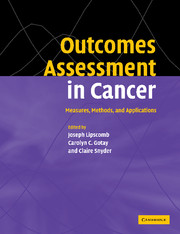Book contents
- Frontmatter
- Contents
- List of contributors
- Acknowledgments
- 1 Introduction to Outcomes Assessment in Cancer
- Health-related quality of life in cancer: general concepts and generic measures
- Assessing health-related quality of life during treatment
- Assessing health-related quality of life across the cancer continuum
- 10 Short-term outcomes of chemoprevention, genetic susceptibility testing, and screening interventions: What are they? How are they measured? When should they be measured?
- 11 Evaluating quality of life in cancer survivors
- 12 Assessing health-related quality of life at end of life
- Measuring the experience and needs of cancer patients and caregivers
- Methodological considerations in applications to cancer outcomes research
- Modern psychometric theory in cancer outcomes research
- Assessing the economic impact of cancer
- Research and policy implications
- Invited papers
- Index
- References
12 - Assessing health-related quality of life at end of life
Published online by Cambridge University Press: 18 December 2009
- Frontmatter
- Contents
- List of contributors
- Acknowledgments
- 1 Introduction to Outcomes Assessment in Cancer
- Health-related quality of life in cancer: general concepts and generic measures
- Assessing health-related quality of life during treatment
- Assessing health-related quality of life across the cancer continuum
- 10 Short-term outcomes of chemoprevention, genetic susceptibility testing, and screening interventions: What are they? How are they measured? When should they be measured?
- 11 Evaluating quality of life in cancer survivors
- 12 Assessing health-related quality of life at end of life
- Measuring the experience and needs of cancer patients and caregivers
- Methodological considerations in applications to cancer outcomes research
- Modern psychometric theory in cancer outcomes research
- Assessing the economic impact of cancer
- Research and policy implications
- Invited papers
- Index
- References
Summary
Assessment of health-related quality of life (HRQOL) at end of life (EOL) can be quite challenging. However, understanding how treatment affects HRQOL during the terminal phases of care is critical to providing the quality of cancer care called for by the National Cancer Policy Board (NCPB) of the Institute of Medicine. The stage at diagnosis, disease progression, and personal and social factors make cancer care at the end of life extraordinarily complex. Inevitably, as one approaches death, symptoms are dynamic and change in an unpredictable fashion, requiring rapid modifications in medications and other therapies. At this time, assessment of HRQOL, as well as patient management, are formidable tasks.
In studying terminally ill populations, it is important to articulate what is meant by palliative and “end of life” care. The World Health Organization (WHO) defines palliative care as the “active total care of patients whose disease is not responsive to curative treatments.” The NCPB has adopted the WHO definition of palliative care, but it also notes that palliative care should begin at the time of cancer diagnosis and extend through the course of the disease to the time of death. While palliative care and EOL care are often seen as equivalent, some make the distinction that EOL care is focused only on the terminal stage, whereas palliative care may extend throughout the disease trajectory. For purposes of this paper, palliative care and EOL care will be used interchangeably, per the WHO definition.
- Type
- Chapter
- Information
- Outcomes Assessment in CancerMeasures, Methods and Applications, pp. 264 - 285Publisher: Cambridge University PressPrint publication year: 2004
References
- 1
- Cited by



